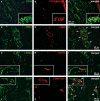Evidence for progressive reduction and loss of telocytes in the dermal cellular network of systemic sclerosis
- PMID: 23444845
- PMCID: PMC3822649
- DOI: 10.1111/jcmm.12028
Evidence for progressive reduction and loss of telocytes in the dermal cellular network of systemic sclerosis
Abstract
Telocytes, a peculiar type of stromal cells, have been recently identified in a variety of tissues and organs, including human skin. Systemic sclerosis (SSc, scleroderma) is a complex connective tissue disease characterized by fibrosis of the skin and internal organs. We presently investigated telocyte distribution and features in the skin of SSc patients compared with normal skin. By an integrated immunohistochemical and transmission electron microscopy approach, we confirmed that telocytes were present in human dermis, where they were mainly recognizable by their typical ultrastructural features and were immunophenotypically characterized by CD34 expression. Our findings also showed that dermal telocytes were immunophenotypically negative for CD31/PECAM-1 (endothelial cells), α-SMA (myofibroblasts, pericytes, vascular smooth muscle cells), CD11c (dendritic cells, macrophages), CD90/Thy-1 (fibroblasts) and c-kit/CD117 (mast cells). In normal skin, telocytes were organized to form three-dimensional networks distributed among collagen bundles and elastic fibres, and surrounded microvessels, nerves and skin adnexa (hair follicles, sebaceous and sweat glands). Telocytes displayed severe ultrastructural damages (swollen mitochondria, cytoplasmic vacuolization, lipofuscinic bodies) suggestive of ischaemia-induced cell degeneration and were progressively lost from the clinically affected skin of SSc patients. Telocyte damage and loss evolved differently according to SSc subsets and stages, being more rapid and severe in diffuse SSc. Briefly, in human skin telocytes are a distinct stromal cell population. In SSc skin, the progressive loss of telocytes might (i) contribute to the altered three-dimensional organization of the extracellular matrix, (ii) reduce the control of fibroblast, myofibroblast and mast cell activity, and (iii) impair skin regeneration and/or repair.
© 2013 The Authors. Published by Foundation for Cellular and Molecular Medicine/Blackwell Publishing Ltd.
Figures









Similar articles
-
A loss of telocytes accompanies fibrosis of multiple organs in systemic sclerosis.J Cell Mol Med. 2014 Feb;18(2):253-62. doi: 10.1111/jcmm.12228. J Cell Mol Med. 2014. PMID: 24467430 Free PMC article.
-
Scleroderma-like Impairment in the Network of Telocytes/CD34+ Stromal Cells in the Experimental Mouse Model of Bleomycin-Induced Dermal Fibrosis.Int J Mol Sci. 2021 Nov 17;22(22):12407. doi: 10.3390/ijms222212407. Int J Mol Sci. 2021. PMID: 34830288 Free PMC article.
-
The Cutaneous Telocytes.Adv Exp Med Biol. 2016;913:303-323. doi: 10.1007/978-981-10-1061-3_20. Adv Exp Med Biol. 2016. PMID: 27796896 Review.
-
Reappraising the microscopic anatomy of human testis: identification of telocyte networks in the peritubular and intertubular stromal space.Sci Rep. 2018 Oct 3;8(1):14780. doi: 10.1038/s41598-018-33126-2. Sci Rep. 2018. PMID: 30283023 Free PMC article.
-
Cd34+ Stromal Cells/Telocytes in Normal and Pathological Skin.Int J Mol Sci. 2021 Jul 8;22(14):7342. doi: 10.3390/ijms22147342. Int J Mol Sci. 2021. PMID: 34298962 Free PMC article. Review.
Cited by
-
A transmission electron microscopy investigation suggests that telocytes, skeletal muscles, myoblasts, and stem cells in common carp (Cyprinus carpio) respond to salinity challenges.BMC Vet Res. 2024 Feb 24;20(1):73. doi: 10.1186/s12917-024-03916-0. BMC Vet Res. 2024. PMID: 38402164 Free PMC article.
-
In vitro morphology, viability and cytokine secretion of uterine telocyte-activated mouse peritoneal macrophages.J Cell Mol Med. 2015 Dec;19(12):2741-50. doi: 10.1111/jcmm.12711. Epub 2015 Oct 16. J Cell Mol Med. 2015. PMID: 26471943 Free PMC article.
-
An Immunohistochemical Study of Gastric Mucosa and Critical Review Indicate that the Subepithelial Telocytes are Prelymphatic Endothelial Cells.Medicina (Kaunas). 2019 Jun 27;55(7):316. doi: 10.3390/medicina55070316. Medicina (Kaunas). 2019. PMID: 31252668 Free PMC article.
-
Telocytes constitute a widespread interstitial meshwork in the lamina propria and underlying striated muscle of human tongue.Sci Rep. 2019 Apr 10;9(1):5858. doi: 10.1038/s41598-019-42415-3. Sci Rep. 2019. PMID: 30971762 Free PMC article.
-
PAI1 mediates fibroblast-mast cell interactions in skin fibrosis.J Clin Invest. 2018 May 1;128(5):1807-1819. doi: 10.1172/JCI99088. Epub 2018 Mar 26. J Clin Invest. 2018. PMID: 29584619 Free PMC article.
References
-
- Gabrielli A, Avvedimento EV, Krieg T. Scleroderma. N Engl J Med. 2009;360:1989–2003. - PubMed
-
- Jain S, Shahane A, Derk CT. Interstitial lung disease in systemic sclerosis: pathophysiology, current and new advances in therapy. Inflamm Allergy Drug Targets. 2012;11:266–77. - PubMed
-
- Manetti M, Neumann E, Milia AF, et al. Severe fibrosis and increased expression of fibrogenic cytokines in the gastric wall of systemic sclerosis patients. Arthritis Rheum. 2007;56:3442–7. - PubMed
Publication types
MeSH terms
Substances
LinkOut - more resources
Full Text Sources
Other Literature Sources
Medical
Research Materials

